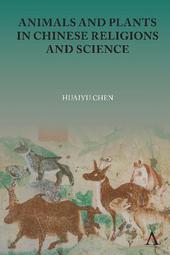
|
Animals and Plants in Chinese Religions and Science
Hardback
Main Details
| Title |
Animals and Plants in Chinese Religions and Science
|
| Authors and Contributors |
By (author) Huaiyu Chen
|
| Physical Properties |
| Format:Hardback | | Pages:250 | | Dimensions(mm): Height 229,Width 153 |
|
| Category/Genre | Alternative belief systems |
|---|
| ISBN/Barcode |
9781839985010
|
| Classifications | Dewey:202.1209510902 |
|---|
| Audience | | Professional & Vocational | |
|---|
|
Publishing Details |
| Publisher |
Anthem Press
|
| Imprint |
Anthem Press
|
| NZ Release Date |
14 March 2023 |
| Publication Country |
United Kingdom
|
Description
This transdisciplinary study focuses on animals and plants in medieval Chinese religions and science. It examines how medieval religious agents engaged with animals and plants as material culture in the mundane world, and how the spiritual world and natural world mutually enriched each other in the medieval world of China. In ancient China, the tradition of observing nature is combined with Yin-Yang and the Five-Phase theories, which were later incorporated into the ancient arts of divination, including the technique of predicting weather changes by observing the behaviour and health of animals. The observation of the close connection between animals and weather developed into the worship of animals, that is, what can be called the cult of animals. Plant science and technology in medieval China cannot be separated from the developments in agriculture, economics, and medicine, as well as cultural practice. The Chinese empire ruled most of East Asia in the medieval period. Numerous species of plants were observed, cultivated, harvested, and used in the vast land of China that spanned a wide range of biomes from boreal through to temperate and tropical, with most regions classed as subtropical. Besides indigenous plants, many plants from West, Central, South, and Southeast Asia were introduced into China and East Asia in general. Numerous zoomantic practices appeared in two sets of textual documents in the premodern Chinese bibliographical system, namely official documents and popular documents. Official documents were often compiled by government officials and served political governance objectives. These documents included official histories, annals, and institutional documents, as well as Confucian classics. The authorship or editorship of these documents was often explicit. Popular documents included strange writings, tales, legends, and religious documents from Buddhism and Daoism, which were often not compiled under the sponsorship and support of the court or government. They might be compiled by literati but lost original authorship. They did not serve political motivations and objectives, reflecting how people understood and interpreted correlative cosmology by observing animal behaviours at the local or non-bureaucratic level. This book is a unique transdisciplinary study on animals and plants in medieval Chinese religions and science, especially in such a critical era of environmental crisis today. In recent years, environment historians have written intensively on China, yet the study of animals and plants in medieval China was less developed, not much about the role of religions, more precisely. This book aims to bridge the gaps between religious studies and environmental studies, between the history of science and religious studies, and between animal studies and plant studies. It also deals with folklores and other literary sources for examining the changing images of animals in the psychological and imaginative experience, which are often overlooked in the conventional scholarship. This book addresses big issues such as how religious agents responded to the challenges about animals and plants as material culture in the mundane world, and how the religious writers developed their different discourse about animals and plants from the state ideology, and how the spiritual world and natural world mutually enriched each other in the medieval world of China.
Author Biography
Huaiyu Chen is Associate Professor of School of Historical, Philosophical and Religious Studies at Arizona State University and Distinguished Visiting Professor of Center for the Yellow River Civilization and Sustainable Development of Henan University in Kaifeng.
|